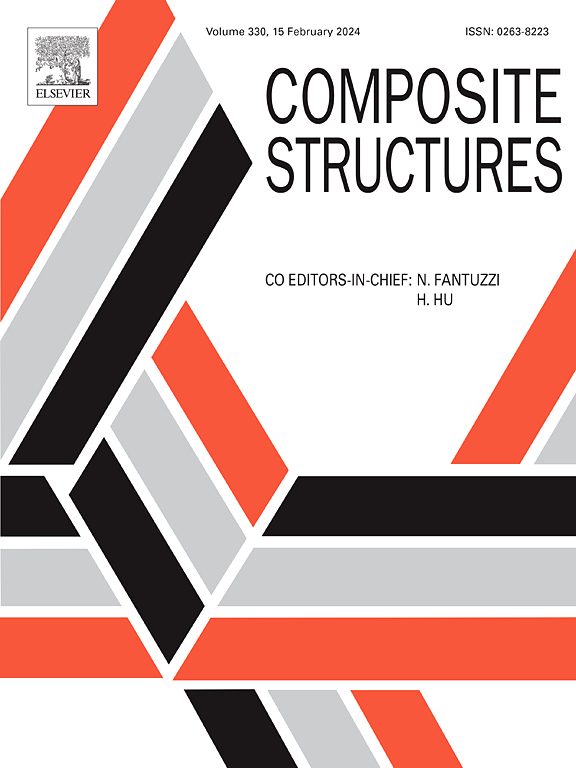Macro-Micro structure engineering for reed-derived biochar composites to achieve synergetic dissipation capacities towards wide-band and strong electromagnetic wave absorption
IF 6.3
2区 材料科学
Q1 MATERIALS SCIENCE, COMPOSITES
引用次数: 0
Abstract
Achieving integration of strong electromagnetic wave (EMW) absorption and wide absorption bandwidth through a single-component carbonaceous absorber is still considered a huge challenge due to the impedance mismatch and limited loss mechanisms. Herein, a reed-derived carbon/epoxy (RC/EP) composite absorber with ultra-wide absorption bandwidth and highly strong EMW absorption was fabricated by simultaneous regulation on the micro-structure of RC and establishment of macro-gradient of RC in EP matrix. The compartmentalized structure and gradient distribution of the optimized RC in the EP matrix boosted the reflection and scattering of the EMW, contributing outstanding impedance matching and synergetic EMW dissipation. Therefore, the RC/EP composite with the thickness of 2.0 mm presented a minimum reflection loss (RLmin) of −54.3 dB and an effective absorption bandwidth (EAB) of 6.12 GHz. Varying the content and distribution of RC, the EAB of the RC/EP can cover 99.7 % of the whole Ku band. In addition, the stealth performance of RC/EP absorbing materials under actual far-field conditions is confirmed using Computer Simulation Technology (CST). This work provides a new way to realize a single-component carbonaceous absorber with both broadband and strong EMW absorbing capability, which can satisfy a wide range of applications in the fields of electronics, medical protection, and architectural invisible materials.
芦苇生物炭复合材料的宏观-微观结构工程,实现宽带强电磁波吸收的协同消散能力
由于阻抗失配和有限的损耗机制,通过单组分碳质吸波材料实现强电磁波(EMW)吸收和宽吸收带宽的一体化仍被认为是一个巨大的挑战。在此,通过同时调节 RC 的微观结构和在 EP 基质中建立 RC 的宏观梯度,制备了一种具有超宽吸收带宽和高强电磁波吸收能力的芦苇衍生碳/环氧(RC/EP)复合吸收体。优化的 RC 在 EP 基体中的分区结构和梯度分布增强了对电磁波的反射和散射,有助于实现出色的阻抗匹配和协同电磁波耗散。因此,厚度为 2.0 mm 的 RC/EP 复合材料的最小反射损耗(RLmin)为 -54.3 dB,有效吸收带宽(EAB)为 6.12 GHz。通过改变 RC 的含量和分布,RC/EP 的 EAB 可以覆盖整个 Ku 波段的 99.7%。此外,利用计算机仿真技术(CST)证实了 RC/EP 吸收材料在实际远场条件下的隐身性能。这项工作为实现具有宽带和强电磁波吸收能力的单组分碳质吸收体提供了一条新途径,可满足电子、医疗防护和建筑隐形材料等领域的广泛应用。
本文章由计算机程序翻译,如有差异,请以英文原文为准。
求助全文
约1分钟内获得全文
求助全文
来源期刊

Composite Structures
工程技术-材料科学:复合
CiteScore
12.00
自引率
12.70%
发文量
1246
审稿时长
78 days
期刊介绍:
The past few decades have seen outstanding advances in the use of composite materials in structural applications. There can be little doubt that, within engineering circles, composites have revolutionised traditional design concepts and made possible an unparalleled range of new and exciting possibilities as viable materials for construction. Composite Structures, an International Journal, disseminates knowledge between users, manufacturers, designers and researchers involved in structures or structural components manufactured using composite materials.
The journal publishes papers which contribute to knowledge in the use of composite materials in engineering structures. Papers deal with design, research and development studies, experimental investigations, theoretical analysis and fabrication techniques relevant to the application of composites in load-bearing components for assemblies, ranging from individual components such as plates and shells to complete composite structures.
 求助内容:
求助内容: 应助结果提醒方式:
应助结果提醒方式:


